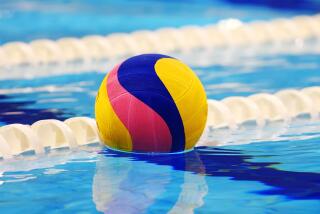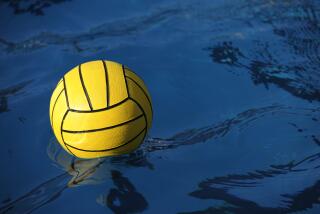On Scale of 1 to 10, This Match Ranks High : Polo: The sport is undergoing a renaissance in Indio, where Hall of Fame caliber players will gather Sunday.
INDIO — Polo, that ancient sport for man and horse first played in Persia more than 2,500 years ago, is undergoing a renaissance among the date palms and tumbleweeds of the Coachella Valley.
The United States Polo Assn. has been celebrating its 100th anniversary this year and as a climax, an all-star match of Hall of Fame caliber players--the Polo Master of the Masters--will field two teams of all 10-goal players Sunday at the Empire Polo Club in Indio.
In the past 10 years, membership in the USPA has almost doubled, from 1,700 members and 146 clubs in 1980 to more than 3,000 members and 266 clubs this year.
Empire is one of the newer clubs, having been founded in 1987 next door to Indio’s famed Eldorado club. Empire has four full-sized fields and Eldorado has nine, making the desert community south of Palm Springs one of the busiest polo sites in the country.
In polo, there is nothing higher than a 10-goal rating. Since 1890, only 33 players have received 10-goal ratings.
The teams, River Plate and Westbury, are all-star aggregations of eight Argentine and two Mexican players, all with 10-goal rankings. There are four players on each side, with two alternates.
“It is so rare that polo has 10 players with 10 handicaps at the same time, let alone have them participate in a competition of this caliber,” said Alexander Haagen III of Los Angeles, Empire Polo Club owner. “The significance of this event in the polo community is relatively unparalleled.”
It is only the second time that a match with all 10-goal players has been arranged. The other was in 1975 in Argentina and was played before 40,000 spectators.
Handicaps range from minus-two for beginners to 10 goals for the best in the world, based on mastery of the fundamentals, horsemanship, sense of strategy and conduct and quality of ponies. Anyone rated at five goals or more is considered a high-goal player.
No American polo player has rated 10 since Tommy Wayman in 1983 and ’84. In the first half of the century, the United States dominated polo the way Argentina does today, and there were a number of American 10-goal players, the most famous being Tommy Hitchcock Jr. Hitchcock was a 10 from 1922 to 1940. He was killed during World War II.
Five of the starters in the game Sunday are from the wealthy Pieres and Heguy polo dynasties of Argentina.
Horacio Heguy and his cousin Eduardo Heguy will play for River Plate, and Gonzalo Heguy, Horacio’s twin, for Westbury. Another Heguy, Marcos, will be an alternate. Heguys represented Argentina in world championship matches as far back as 1966. There were two Heguys--fathers of Horacio, Eduardo and Gonzalo--in the other 40-goal game 15 years ago.
Gonzalo Pieres and Alfonso Pieres will also play against one another. Gonzalo will be captain of River Plate. Alfonso has been a 10-goal player for eight years and was a member of the winning World Cup team for five consecutive years. The Pieres brothers breed and train polo ponies and are founding members of the Pilar Chico Polo Club, home base for many high-goal players near Buenos Aires.
The two Mexicans, Carlos and Memo Gracida, are also brothers from a traditional polo family. Both live in Palm Beach, Fla., where they also train polo ponies.
“The teams are very well balanced and no one has a distinct advantage,” said Memo Gracida, who will be captain of the Westbury four.
Memo has had a 10-goal rating since 1980, longer than any other player. Carlos, who will play for River Plate, gained his 10-goal distinction in 1985.
In 1946, in an international match against the United States, the entire Mexico lineup was composed of Gracidas--Gabriel, Guilliermo, Alejandro and Jose.
The other starter for Westbury is Ernesto Trotz, another Argentine. Their reserve is Benjamin Araya, who attained his 10-goal rating last year in Argentina.
A polo game consists of six periods, called chukkers, each lasting a little more than seven minutes and played on a 10-acre field, 160 yards by 300 yards, with goals at either end that are eight yards wide. A warning horn sounds after seven minutes and play continues for 30 seconds unless a goal is scored or the ball is knocked out of bounds.
The name polo is derived from a Tibetan word, pelu, which means ball. In the 13th century, the Mongols carried the game to India, where six centuries later it was discovered by British tea planters, who turned it into a sport for aristocrats. Today, there are 800 clubs in 53 nations playing polo, but the heart of the sport is in Argentina.
Polo ponies, which are not ponies at all but usually are thoroughbred horses bred with quarter horses, are changed every chukker. A team of four riders needs a stable of 30 horses for a game. There are no timeouts or substitutions unless a horse or player is injured.
The maximum height for an actual pony is 14.2 hands but most polo mounts stand 15 to 16 hands, a “hand” being four inches.
A top polo pony, most of which come from Argentina, can cost up to $20,000.
The ball is hard plastic, 3 1/2 inches in diameter and weighing four ounces. Mallets are up to 54 inches long with a cigar-shaped head made of hardwood. A well-struck ball hit from a pony traveling at 35 m.p.h. can reach speeds of more than 100 m.p.h.
Arena, or indoor polo, such as has been played since 1983 at the Los Angeles Equestrian Center in Griffith Park, is a cut-down version of the outdoor game. It has three players on a side and is played on a smaller field, 150 by 300 feet, using a softer, rubber ball and is played for only four chukkers.
As in hockey or soccer, bumping an opponent to prevent him from controlling the ball is not only legal, but highly praised as a defensive tactic. The only rule is that the angle of collision not be more than 45 degrees.
One of the delightful traditions in polo occurs after three chukkers--during halftime--when spectators pour onto the field and participate in a bit of grounds keeping that is called “divot stomping.”
It is both a necessary ritual to help smooth out the rough spots caused by the abrupt turning and pivoting of the horses and a social one that encourages a mingling of the patrons.
In England, when Prince Charles is playing, even the Queen has been known to be a divot stomper.
Many enthusiasts say that the future of the game in America lies with developing strong high school and college programs, which are overseen by the USPA’s Polo Training Foundation.
There are 26 colleges and 10 high schools with polo teams. Among them on the West Coast are UC Davis, which lost in the collegiate final to Colorado State; Cal Poly San Luis Obispo, Stanford, Washington State, Oregon State and the Robert Louis Stevenson prep school in Northern California.
The Santa Monica Polo Club was California’s first, founded in 1898, two years before the USPA was formed to standardize rules and conduct championship tournaments.
Southern California was a hotbed of polo activity in the 1930s and ‘40s when there were fields at the Midwick Country Club in Monterey Park and Riviera, Uplifters Club and Will Rogers Park in Pacific Palisades.
Cecil Smith, Elmer Boeseke and Robert Skene were all local favorites who attained 10-goal ratings. Skene played on national championship teams for Beverly Hills in 1952 and Santa Barbara in 1962.
Eric Pedley, who captained the Midwick team that won the national championship in 1924, was a nine-goal player. Pedley scored a record 12 goals in 1936 when his United States team defeated Hurlingham of Great Britain, 20-4.
There are 25 active clubs in the state, including ones in Santa Barbara, Rancho Santa Fe, Ventura and the two in Indio.
More to Read
Go beyond the scoreboard
Get the latest on L.A.'s teams in the daily Sports Report newsletter.
You may occasionally receive promotional content from the Los Angeles Times.









